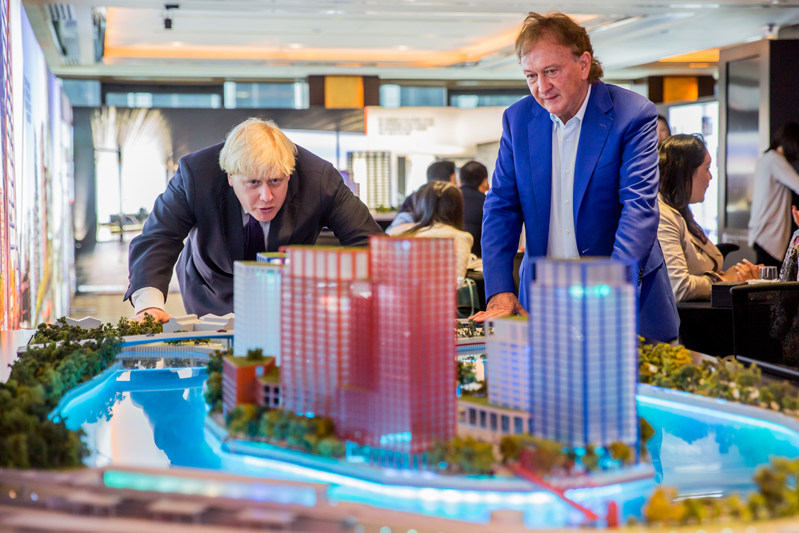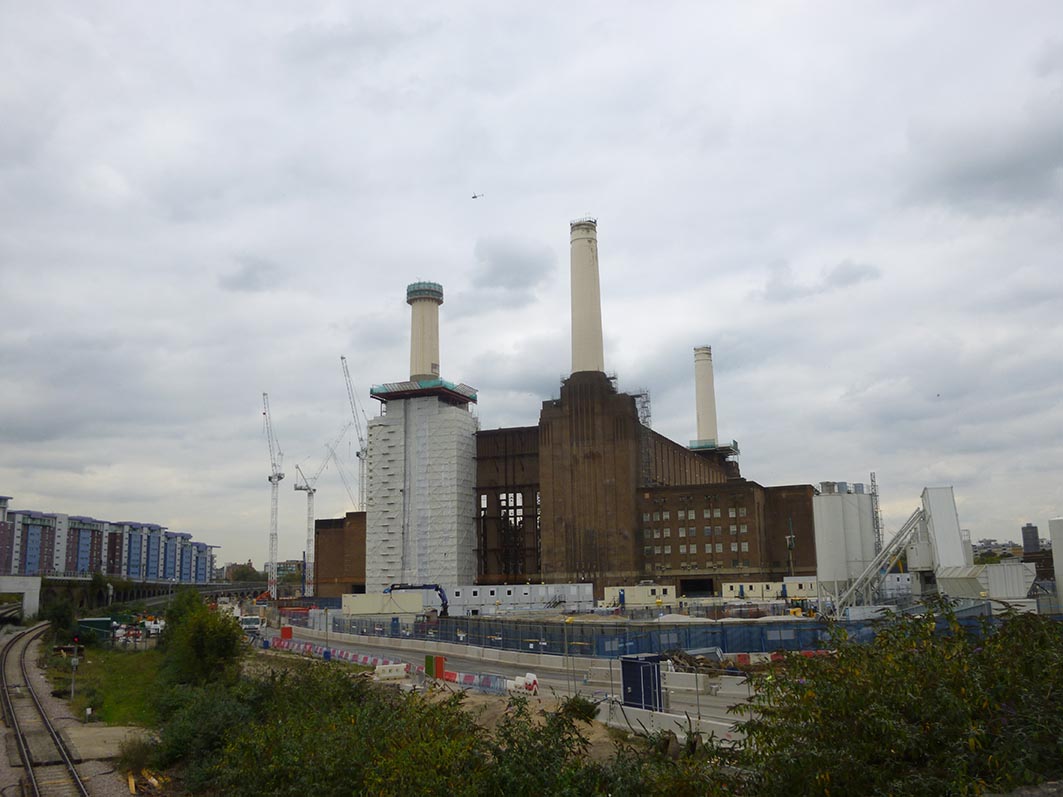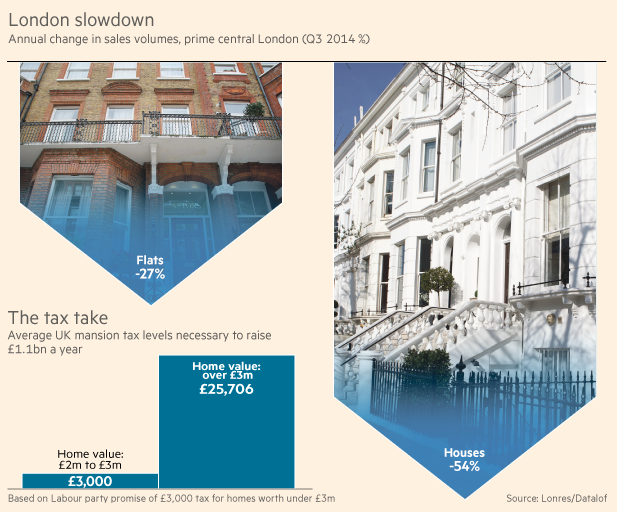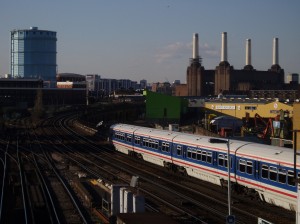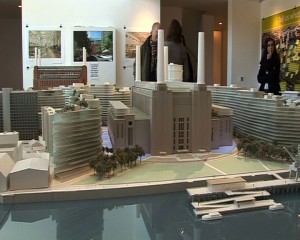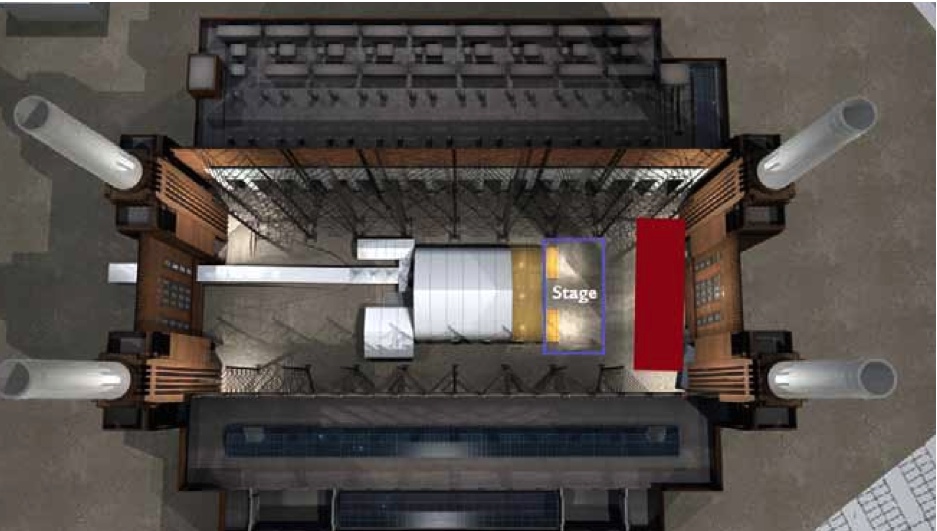In questi giorni Battersea Power Station andrà in giro per il mondo a vendersi. Un tour pubblicitario globale per lanciare, probabilmente, il più grande progetto di sviluppo immobiliare del momento a Londra e, certamente, tra i più controversi. La pubblicità è iniziata con un articolo di Enrico Francechini su Repubblica, che presenta il megaprogetto per i suoi aspetti avveniristici. Tuttavia non coglie gli aspetti critici della speculazione edilizia, il contesto di housing crisis e il rischio di cancellare l’icona del passato industriale Londinese (in bello stile art deco) lungamente denunciato dal Battersea Power Station Community Group. Un recente articolo del Financial Times, dando spazio al World Monument Fund e alle sue preoccupazioni, ci sembra che tenti di contestualizzare il lavoro dell’impresa immobiliare (Battersea Power Station Development Company).

Il brand usato dalla Battersea Power Station Development Company
Probabilmente per un italiano medio Battersea Power Station non significa granché, ma se aggiungi la copertina di Animals dei Pink Floyd allora dalla memoria qualcosa affiora.

Copertina del celebre album
Animals dei Pink Floyd
Per i londinesi Battersea Power Station rappresenta molto di più: un’icona del passato industriale e un punto interrogativo sul futuro dello sviluppo immobiliare della capitale britannica. Costruita a partire dagli anni ’30, questa cattedrale industriale fino all’inizio degli anni ’80 ha fornito elettricità alla metropoli, calore nelle sue case e ha dato un decisivo contributo alle affascinanti e nebbiose atmosfere stile “fumo di londra”.
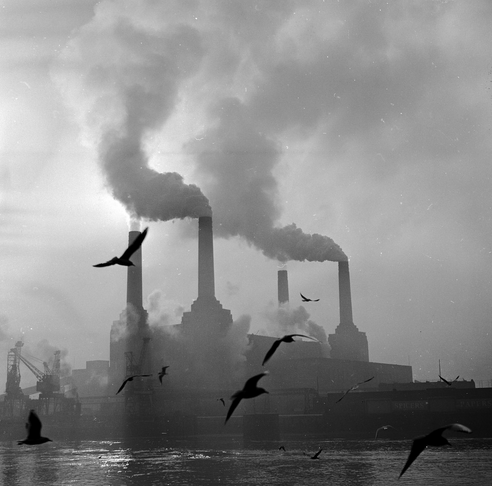
Contributo della Battersea Power Station all’inquinamento di Londra e alle sue atmosfere fumose (getty images)
Battersea Power Station fa parte dell’immaginario di milioni di frequentatori della capitale, stagliandosi nei finestrini dei pendolari che ogni giorno transitano dalle stazioni ferroviarie di Vauxall, Clapham e Victoria Station. La bellezza dell’edificio e delle enormi ciminiere bianche, il condensato di storia industriale che incarnano hanno fatto sì che la Battersea Power Station entrasse già nel 1980 nella lista degli edifici storici. A partire dal 2004 il prestigioso World Monument Fund ha incluso Battersea Power Station e le sue ciminiere nella lunga lista di edifici patrimonio dell’umanità che necessitano di essere protetti per i posteri. Ma da cosa bisogna proteggere Battersea Power Station?
Chiusi i battenti, l’enorme area industriale attorno alla centrale elettrica e lo stesso edificio sono a lungo rimasti abbandonati a se stessi, passando di mano in mano tra diversi investitori che hanno tentato di proporre i più disparati progetti di sviluppo, mai andati oltre annunci o parziali demolizioni dell’esistente (come il tetto, per esempio, da parte di precedenti proprietari)
STORIA DELLA BATTERSEA POWER STATION
Primi Piani: 1980-90
Nuovi Piani: 1993
GIORNI NOSTRI
Ma questa volta la Battersea Power Station Development Company, braccio operativo di una cordata di società e istituti finanziari della Malesia, sembra fare sul serio: archistars (Frank Gehry, Norman Foster, Rafael Vinoly), budget faraonico (8 miliardi di sterline, circa 10 miliardi di euro) e la benedizione di sindaco e primi ministri dovrebbero permettere di creare, la’ dove ora c’e’ una cadente centrale elettrica, il centro di una nuova città nella città.
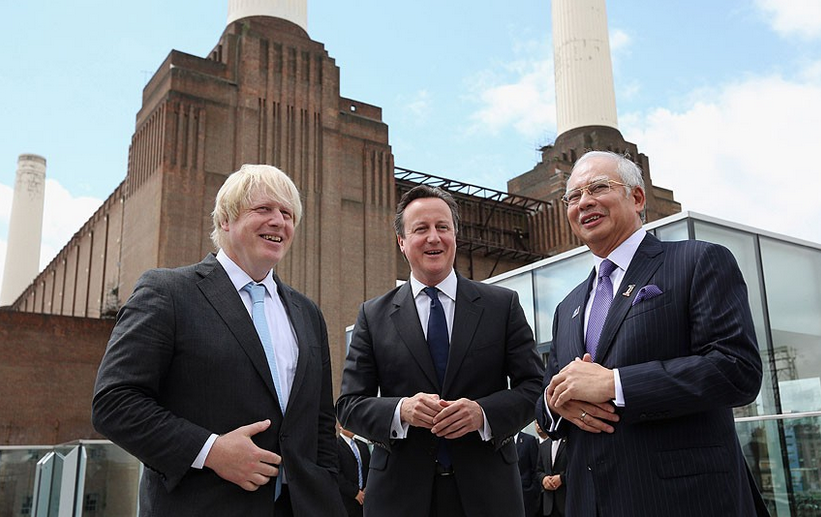
Da sinistra: il sindaco di Londra (Boris Johnson) il primo ministro inglese (David Cameron) e il primo ministro della Malesia (Datuk Seri Najib Razak) alla cerimonia d’inizio lavori alla Battersea Power Station (4 luglio 2013). Source: Daily Telegraph
In questi giorni la Battersea Power Station Development Company porta in un tour globale i suoi progetti, in cerca di investitori stranieri pronti ad acquistare un posto nel nuovo nel centro che hanno intenzine di costruire. Anche gli Italiani avranno modo di esserne parte: la campagna pubblicitaria passerà da Milano dal 5 al 9 novembre. Per chi si fosse perso la notizia, il lancio del tour, almeno per il pubblico italiano, è avvenuto grazie a un lungo articolo di Repubblica che porta la prestigiosa firma di Enrico Franceschini, suo inviato a Londra.
Invitato dalla Battersea Power Station Development Company a “dare un’occhiata da vicino e a fare due chiacchiere”, l’inviato restituisce un entusiastico affresco delle infinite capacità di una città capace di guardare al futuro per reinventarsi attraverso progetti da sogno. Tra le righe Franceschini sembra quasi suggerire di prendere esempio e evidenziare ciò che manca a noi poveri italiani, impelagati nel presente e appesantiti da un passato di cui non sappiamo bene cosa fare. Chi si prenderebbe la briga di reinventare quartieri interi, investire miliardi per il futuro di Roma o Milano?
A Londra invece si può e la Battersea Power Station Development Company pensa a tutto: giardini d’inverno sul tetto della centrale, negozi e spazi espositivi, oltre che spazi abitativi per 100.000 persone e una deviazione della metro fino nel cuore del nuovo e straordinario “villaggio”.
Allora benvenuto sviluppo e capacita’ di fare: benvenuta “Città Futura!”
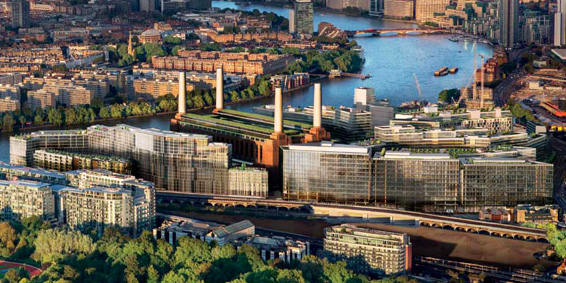
Veduta aerea del progetto come dovrà essere a conclusione lavori. In mezzo ai grattacieli si intravede la centrale elettrica.
Peccato che dal simpatico affresco del nostro caro Franceschini manchino un po’ di fatti e alcuni altri vengono presentati in maniera tanto semplicistica da apparirci sbagliati, o perlomeno fuorvianti. Per chi non abbia ancora avuto la possibilità di saperne di più, ecco i principali.
Londra è probabilmente al picco del suo mercato immobiliare e, contemporaneamente, della sua capacità di attrarre migranti d’ogni sorta dal resto del mondo. Con il venir meno di piani e finanziamenti per abitazioni sociali e un mercato pompato da enormi liquidità provenienti dai gruppi finanziari e magnati di mezzo mondo, la gente “normale” si trova coinvolta in una paurosa crisi abitativa. Il fenomeno va avanti da almeno trent’anni ma gli effetti, in un contesto di crisi, austerità e con un mercato degli affitti alle stelle, sono devastanti e raggiungono fasce sempre più ampie della popolazione. Mentre si investono miliardi in edifici avveniristici, a Londra non ci sono nuovi appartamenti, non dico per i poveracci immigrati da mezzo mondo, ma nemmeno per la middle class locale.
Il Financial Times, invitato a scrivere sul progetto più o meno come Repubblica, riporta l’opinione di Peter Rees, un famoso urbanista, esperto di pianificazione e docente al prestigioso University College London.
“Peter Rees […] has described the proliferation of new, largely residential, towers along the south bank between Battersea and London Bridge as “a disaster” that is “ruining London”.”
Questo parere tombale introduce un rapido excursus dei problemi relazionati al mercato immobiliare londinese e ai megaprogetti di sviluppo, come quello di Battersea. Non che il Financial Times sia la bibbia, o che le preoccupazioni del pubblico britannico siano le stesse di quello italiano, ma forse contestualizzare un po’ questo progetto sarebbe stato interessante anche per i lettori di Repubblica. Soprattutto coloro che si apprestano a valutare da vicino, come suggerito dall’articolo, la possibilità di acquistare un appartamento nel complesso della Battersea Power Station.
Per Franceschini a Battersea “…se c’è un difetto è quello che la Città Futura sulla riva sud del Tamigi sembra un set cinematografico […] Ma lo stesso si può dire di Canary Wharf, la nuova City degli affari più a est sempre affacciata al fiume, o dell’Olympic Park, il quartiere dell’East Side rigenerato dalle Olimpiadi del 2012. Con un po’ d’immaginazione si può intravedere come sarà la Londra del 2020 o del 2030, un po’ New York, un po’ Las Vegas, un po’ Old London, un po’ Luna Park.”
Secondo noi di difetti (e rischi) ce ne sono, e sono ben altri.
Ciò che ha reso Battersea Power Station l’icona gotico industriale che attualmente rappresenta sono le ciminiere bianche. In passato Spectacle ha supportato e documentato su questo blog le campagne in difesa della centrale e, in particolare, delle sue ciminiere. La proprietà sostiene che le ciminiere siano un pericolo, in quanto danneggiate dal tempo e rese pericolanti dalla mancanza di manutenzione degli ultimi 30 anni almeno. A tale scopo Battersea Power Station Development Company ha in mente di demolirle per sostituirle con copie nuove di zecca che ne garantiscano la solidità per gli anni a venire.
Franceschini affronta l’argomento con un simpatico, quanto sibillino, inciso che potrebbe apparire di poco conto:
“Non c’è pericolo che i comignoli bianchi cadano in testa ai nuovi inquilini: quelli verranno abbattuti delicatamente e rifatti uguali ai vecchi ma nuovi, per ragioni di sicurezza, mentre il resto dell’antica struttura, ben rinforzato, rimarrà dov’è.”
In realtà questa è precisamente la posizione dell’impresa, il cui CEO è arrivato a paventare rischi imminenti di crolli, anche in caso di folate di vento più forti del solito.
Diversi elementi fanno dubitare sul fatto che le ciminiere rappresentino un pericolo concreto. Se le nostre inchieste e le interviste realizzate con i membri del Battersea Power Station Community Group, promotori delle campagne di difesa della centrale da speculazioni e distruzioni, possono sembrare parziali, torniamo al Financial Times e a come affronta lo stesso argomento.
La scelta, in questo caso, è stata quella di affidare al World Monument Fund uno spazio in calce all’articolo per presentare la propria posizione nei confronti del progetto. Dalle righe a firma Jonathan Foyle, chief executive del World Monuments Fund Britain, si scopre che questa pericolosità è contestata da tre autorevoli studi:
“In 2005, three engineers concluded the existing chimneys could be repaired in-situ. Instead, they are to be razed and rebuilt as smoke stacks that never smoked, reducing long-term maintenance.”
Fatto sta che le ciminiere stanno venendo giù, e anche rapidamente, in barba a tutti i tentativi operati dagli attivisti del Battersea Power Station Community Group di far valutare a impresa e municipio piani alternativi di restauro. Inoltre le garanzie predisposte affinché l’impresa effettivamente proceda alla ricostruzione delle ciminiere sembrano essere state aggirate. Se in un primo momento il municipio aveva imposto alla compagnia di procedere alla demolizione e immediata ricostruzione di una ciminiera per volta, nuovi accordi hanno stabilito che dopo aver abbattuto e cominciato a ricostruire la prima ciminiera, le altre tre potranno essere smantellate tutte insieme.
Inoltre è stato chiesto all’impresa di depositare in un conto vincolato fondi sufficienti a garantire la ricostruzione, anche in caso di fallimento improvviso o vendita a terzi del progetto (le dinamiche del passato fanno credere che non siano ipotesi tanto remote…). Il fondo depositato è di 11 milioni di sterline (14 milioni in euro, un po’ pochino a detta di un ingegnere della stessa Battersea Power Station Development Company) e il deposito è stato effettuato in una banca malese. Secondo gli attivisti in caso di effettivo fallimento della Battersea Power Station Development Company, sarebbe quasi impossibile riscuotere i soldi di garanzia.
Battersea Power Station è solo uno dei centinaia di progetti di development finanziati da gruppi immobiliari a capitale britannico o internazionale, tutti extralusso. Questi progetti spesso creano bellissimi e avveniristici quartieri, ma spettrali: i primi acquirenti sono, normalmente, gruppi immobiliari e affaristi di mezzo mondo che comprano e vendono appartamenti come titoli azionari. Questi proprietari, che Battersea Power Station Development Company apparentemente sta cercando di raggiungere nel suo tour globale, sono normalmente in cerca di curve di mercato che garantiscano utili, più che di esperienze urbanistiche e vedute mozzafiato. Lo scarso interesse verso la reale esperienza abitativa degli investitori rende più che sospettosi circa l’attenzione che la Battersea Power Station Development Company riporrà nella salvaguardia architettonica del sito.
Click Battersea Power Station for more blogs
See our Battersea Power Station project pages for more information and videos.
Or visit PlanA our general blog on urbanism, planning and architecture.
Spectacle homepage
Like Spectacle Documentaries on Facebook
Follow SpectacleMedia on Twitter
